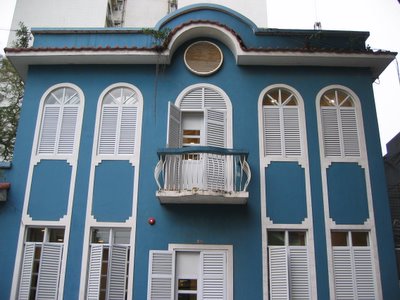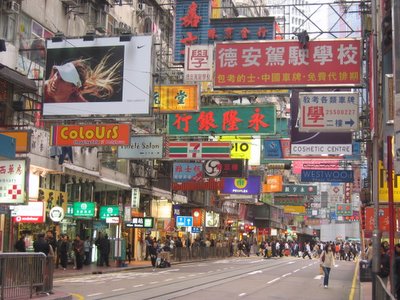 Portugese style building in Largo do Senado
Portugese style building in Largo do Senado We loved the gorgeous colourful facades of the Portugese influenced architecture, so much blue, yellow, pink, green, much more preferable to the usual 10 shades of grey on the mainland! Once again it was difficult to believe that we were still in China, the Catholic Churches on just about every corner are a far cry from the Tibetan monasteries and Muslim mosques that we had seen previously in our trip. Armed with a brand new camera from Hong Kong, there was plenty of scenery to keep us happy snappers busy. .
 Macanese tarts and scooters, two icons of Macau
Macanese tarts and scooters, two icons of Macau
There seems to have been a real effort to maintain the Portugese feel, with old colonial buildings and forts restored and all signs written in both Portugese and Chinese. With the cobbled back streets filled with fashionistas on their European scooters, you could have easily believed that you had been transported half a word away, if it weren't for all the black hair perhaps.
 The facade of the church of St Paul
The facade of the church of St Paul
Doing up your car is obviously the thing to do with plenty of nice ones cruising the narrow streets and laneways. It is also probably the first and only time we are likely to see Vespas and Lambrettas covered with Astro Boy, Seasame Street and Hello Kitty stickers! Though they are definitely serious about style here, no Honda Dreams or Waves, all the bikes are European or "European styled".
The antique furniture shops provided the temptation to spend some money for a little while, but having no abode and no fixed address (and with no prospect of having one for a while), the fantasies were swifty put to an end.
 Macanese colour (and laundry)
Macanese colour (and laundry)
 More Macanese colour
More Macanese colour
 Even further Macanese colour
Even further Macanese colour
The Macau Museum was one of the best we have seen (the quality of the English explanations made us suspect that most of the exhibitions may have been created before the handover), particularly the comparisons between Portugese and Chinese culture at the time of colonisation. After having spent some time walking around the place it was good to see the ways in which the two cultures had influenced each other.
Macau also offered a nice change to our palettes with yummy Macanese cuisine to try. We feasted on delicious seafood, chorizo and portuguese chicken and for the first time in ages, proper rosetta rolls and extra virgin olive oil to dip in. It was gastronomic heaven topped off with special Macanese tarts that were derived from the unique combination of Chinese 'darn' tarts and Portuguese tarts. Aimes had trouble resisting them (and the almond/mung bean cookies) after each meal and borded the bus out of Macau to Guangzhou a couple kilos heavier, armed with her brand new saddle bags.
 Coloane Wharf
Coloane Wharf Drying fish in a village on Coloane
Drying fish in a village on Coloane
There is definitely a sea-faring feel in Macau, with it's many forts, harbours and Ama Temples (for the Chinese fishermen). Particularly on the 'islands' of Taipa and Cologne (they have long been linked to each other by a massive causeway), where we walked around and explored the quaint fishing villages. Even the beaches are European styled - complete with unattractive black sand! As at Tai O in Hong Kong these villages were so quiet and sleepy that it was hard to fathom that we were only a 30 minute bus ride away from the centre of town.
 Super Bock!
Super Bock! The Roman Catholic influence - the Chuch of St Dominic
The Roman Catholic influence - the Chuch of St Dominic
Perhaps the only downside we experienced during our time in Macau was being reaquainted with mainland tourists, which very quickly reminded us that the politeness and courtesy we had been revelling in while in Hong Kong was but a brief respite. No more people holding doors open for you or complete strangers in coffee shops offerring to call their son to find out directions for you, just pushing and shoving, walking in front of your photos and coughing (in your face)! Can't wait to get back to the proper China in a couple of days!
 We're not on the mainland anymore, Toto (and Hobbes road testing the new camera)
We're not on the mainland anymore, Toto (and Hobbes road testing the new camera)
On our last night we thought we couldn't really come to Macau without checking out the casinos. We checked out the Lisboa, one of the originals and seemingly still one of the most popular. It was full of many mainlanders, almost exlusively men, all eager to part with some of their hard earned. The casino isn't flash, there's none of the flashing lights, fake palm trees and tacky art works that make other casinos so appealling, guess people were there for one reason only- to gamble! In fact the two floors looked exactly the same, except one was non-smoking and the other smoking (and smokey - so much so that it would have been difficult for the gamblers to see their cards!).
 Macau isn't immune to the Chinese construction boom
Macau isn't immune to the Chinese construction boom
 Bakery-goodness (fresh almond cookies that contibuted to Aimes' saddle bags)
Bakery-goodness (fresh almond cookies that contibuted to Aimes' saddle bags)
So that was it for the SAR's (Special Administrative Regions), from here it was back to the mainland for a few more weeks. The boarder crossing from Macau into Guangdong was almost as interesting as the lift at Hong Kong with hundreds of people crossing pulling little trolleys with one box on each. Not sure what it was all about, but must have had something to do with avoiding taxes or duties on imports?
 Why most Chinese love Macau
Why most Chinese love Macau




 The commercial heaven of Causeway Bay
The commercial heaven of Causeway Bay 









 Waiting for a bus on Lantau Island
Waiting for a bus on Lantau Island 



 Connaught Road, Central
Connaught Road, Central





 Ping An Village
Ping An Village







 The Li River obscured by us
The Li River obscured by us A queue of Guilin tour boats on the Li River
A queue of Guilin tour boats on the Li River